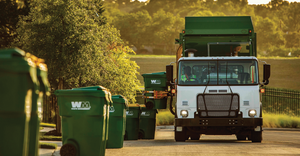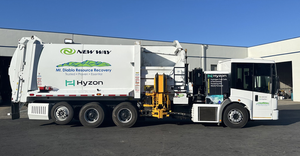New York City Takes Major Commercial Waste Zones Step

On November 16, New York City’s Department of Sanitation released the second and final part of its Request for Proposals for private haulers interested in participating in the Commercial Waste Zones city plan. In this month’s edition of the Business Report, we synthesize the key factors in the process.
The Basics and the Timing
After a pandemic induced delay, New York City’s Department of Sanitation (DSNY) is now moving forward on its plan to develop Commercial Waste Zones (CWZs) within the city, dramatically changing how private haulers service commercial waste generators in New York City (NYC). The DSNY intends to select up to three carters (haulers) within each of the 20 non-exclusive commercial waste zones, as well as up to five haulers to provide container services citywide. The contracts are ten years in duration, with potential extensions out to 2042. Haulers can be awarded contracts in up to 15 of the 20 zones and one citywide contract. Responses to the Request for Proposals (RFPs) are due by March 17, 2022. Selections and awards could be made by the Summer of 2022, with transition occurring in late 2022 into 2023, and with final implementation slated by 2024.
Who are the Potential Players?
Out of the first round of the RFPs issued last November, 50 carters had responsive submissions, who are now eligible to bid in the second and final round. Currently, roughly 90 carters operate in NYC. The 50 potential bidders include large, new (or newly returned) companies such as Winter Bros. and Waste Management, large, already established companies in NYC, notably Waste Connections and Action Environmental Services, as well as a wide range of the current local carters. Interestingly, Rubicon Global has also thrown its hat into the ring, which given its “asset light” model, implies its proposal is likely to involve subcontracted local haulers. Other joint ventures and subcontracting agreements are also likely given the selection criteria, which will be detailed in the following paragraph. But, bottom line, the criteria for sufficient capacity to service the contracts, and the DSNY’s desire for greener fleets, are likely to favor the larger companies, while experience and knowledge of the local market (also part of the criteria) will likely favor the smaller, current local haulers, again indicating the likelihood of joint ventures and subcontracting within the proposed contracts.
Criteria for Selection
Very broadly, the criteria break down to 35% price, 35% technical proposal and 30% on the bidder’s capacity to provide service and its operational history. Within the price component, the bidder must propose a price for recyclables and organics, as well as commercially generated solid waste, with the intent to promote NYC’s zero waste goals. The technical piece encompasses a focus on NYC’s goal for greener, lower emission fleets to address both greenhouse gas emissions (GHGs) and overall air pollution. The technical piece also addresses the goal for enhanced safety measures and requirements, including the requirement that all commercial vehicles must be equipped with GPS to track vehicle safety performance. The capacity and operational history criteria contain a focus on market experience, which benefits the local carters, but it is also focused on compliance history and safety practices.
As opposed to the absolute rate cap that the NYC haulers currently work under, there would be a new maximum price proposed by the bidders within each zone in each bid, but with the opportunity for automatic annual rate increases. The maximum rate will be set within the final agreement with the DSNY, and bidders must include their maximum proposed rates in the proposals. Carters and commercial customers will then negotiate within the maximum price, to assure some level of competition. As touched upon previously, among other requirements, the technical piece of the proposals must include a zero waste plan, an air pollution reduction plan, a health and safety plan and a waste management (processing and disposal) plan, as well as a very extensive customer transition and service plan, as another NYC goal is to make pricing and service more transparent for the commercial customer.
In a related action, the DSNY has also published three final rules related to safety, customer service and operations, and third-party audits, which set minimum requirements for carters operating under the CWZ program. Although there has been some talk or push to try to delay the transition to CWZs further, in general, the second and final RFP was considered to be fairly consistent with expectations.
The Goals—And the Ensuing Potential Pros and Cons
Again, broadly speaking, the overarching goals and the drive behind the genesis of the CWZ plan are to reduce truck traffic and emissions, improve safety, and help NYC reach its green and zero waste goals. According to a 2019 review, it was estimated that CWZs would nearly double diversion rates of recyclables and organics, while decreasing truck traffic and associated emissions by 50%. To that end, the DSNY is looking to see proposed fleets of at least 50% zero emission vehicles by 2030, and new or expanded processing capacity for recyclables and organics. To encourage more recycling and organics diversion and move toward its zero waste goals, DSNY would also like to see prices for recyclables and organics services to be at least 30% lower than for solid waste. NYC is currently stuck around a sub-20% recycling rate as of the last data.
At current, high levels of recycled commodity prices, that desire appears to be more doable, but it is worth noting that it goes against, or is at least at odds with, the current industry trend, particularly among the largest players, to price recycling services on a fee-for-processing service basis, which takes the commodity risk element out of the business, or at least lessens it. It is thus possible that this DSNY desire to price recyclables and organics processing 30% lower than solid waste may result in a return to the old, early days model, where solid waste pricing was often used to subsidize recycling services.
Another potential negative for the commercial waste generators includes the likelihood that rates will rise (the more likely question is really by how much) for commercial customers in NYC at a time when NYC’s businesses, both large but especially small, are still recovering from the impacts of the pandemic. Though contributing to the overall health and safety of NYC residents and providing significant environmental benefits, the fleet and safety requirements and the higher diversion goals will require material incremental investment (and thus higher costs). Additionally, as has been noted by both critics and proponents of further delay to the CWZ plan, the substantial remaining uncertainty with regard to the pace of economic recovery in NYC, and thus the difficulty in projecting both short- and long-term volume levels and trends, could also result in higher prices proposed, in order to compensate for the higher risk involved, particularly at this juncture. Typically, or more specifically pre-pandemic, NYC’s more than 100,000 commercial businesses generated more than three million tons of waste, but obviously the city remains below those levels at present.
About the Author
You May Also Like




